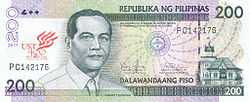Philippine two hundred peso bill
| (Philippines) | |
|---|---|
| Value | ₱200 |
| Width | 160 mm |
| Height | 66 mm |
| Security features | Security fibers, Watermark, See-through mark, Concealed value, Security thread |
| Paper type |
80% Cotton 20% Abacá fiber |
| Years of printing | 1903–1928; 1968–1974; 2002–present |
| Obverse | |
.jpg) | |
| Design | Diosdado Macapagal, EDSA People Power 2001, Aguinaldo Shrine, Barasoain Church |
| Designer | Design Systemat[1] |
| Design date | 2010 |
| Reverse | |
.jpg) | |
| Design | Chocolate Hills, Bohol, Philippine Tarsier (Tarsius syrichta), Visayas weave design |
| Designer | Design Systemat[2] |
| Design date | 2010 |
The Philippine two hundred-peso bill (₱200) is a denomination of Philippine currency. Philippine president Diosdado Macapagal is currently featured on the front side of the bill, while the Chocolate Hills and the Philippine tarsier is featured on the reverse side.
Pre-independence history
- 1903-1928: BPI issued notes. Features a vignette of Lady Justice on the front.
Post-independence history
Macapagal first appeared on the two hundred peso bill upon the reintroduction of the denomination in 2002.
- 1968: English series, Features the portrait of Manuel L. Quezon, the 1st president of the Commonwealth of the Philippines. The reverse features the Old Legislative Building. The Legislative Building was later featured on the fifty peso bill upon the introduction of the Pilipino series notes.
- 1974: The 200 and 500 peso notes were withdrawn from circulation on December 31, 1957, pursuant to Philippine Republic Act No. 1516.[3]
- 2002: New Design series, The two hundred peso denomination was not included on the Pilipino and Ang Bagong Lipunan series. The denomination however was reintroduced in 2002, when the New design series notes was then currently being circulated. The bill now features the portrait of Diosdado Macapagal, the 9th President of the Philippines. The obverse also features the Aguinaldo Shrine, where Emilio Aguinaldo proclaimed the country's independence in 1898, on the lower right corner. The reverse features a scene from EDSA II, with Gloria Macapagal-Arroyo, Macapagal's daughter, being sworn in as president by Chief Justice Hilario Davide Jr. in January 2001. The color of the bill is predominantly green.
- 2010: New generation series, The portrait of Diosdado Macapagal was revised, the Arroyo oathtaking was moved from the reverse to the lower left of the obverse with the Aguinaldo Shrine at the background and the Barasoain Church was added on the lower middle. The reverse now features the Chocolate Hills and the Philippine tarsier.[4]
-

English series ₱200 bill.
Commemorative issues

The UST Quadricentennial commemorative note.
- 60 years of Central Banking commemorative bill - On July 9, 2009, the Bangko Sentral ng Pilipinas introduced 12 million banknotes (2 million banknotes for each denomination) with an overprint commemorating 60 years of central banking. The overprint appears on the watermark area on all six circulating denominations.
- UST Quadricentennial commemorative bill - Unveiled before the press conference held on January 21, 2011, Bangko Sentral ng Pilipinas (BSP) issued commemorative 200-peso bills with the Quadricentennial logo (Tongues of Fire) of the University of Santo Tomas (UST) overprinted on it. BSP released two-billion-pesos (10 million notes) worth of these 200-peso bills—in general circulation and legal tender. In addition, the central bank also released 400 copies of uncut two-piece 200-peso bills (amounting to PhP 400.00).[5]
Notes
- ↑ http://www.esquiremagazine.ph/the-magazine/how-to-make-money
- ↑ http://www.esquiremagazine.ph/the-magazine/how-to-make-money
- ↑ Philippine Republic Act No. 1516 Chan Robles (www.chanrobles.com) Retrieved on 2012-11-24.
- ↑ Cory, Ninoy together again on new 500-peso bill, Jam Sisante, GMANews.TV, December 16, 2010
- ↑ UST set to open Quadricentennial Week. Varsitarian.net. Retrieved January 21, 2011.
| ||||||||||||||||||||||||||